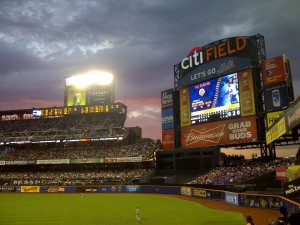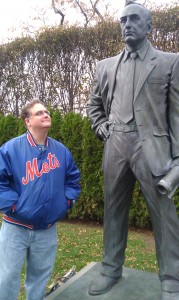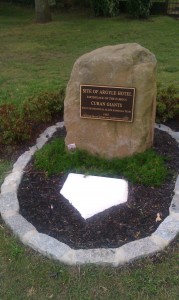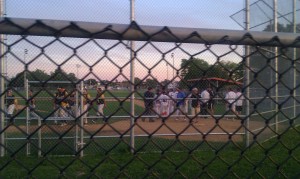Ike Davis…he was at that Mets holiday party a couple of weeks ago, too. His attendance got kind of lost in the shuffle given the kerfuffle that was kicked up by the remarks of his (now erstwhile) teammate, but Ike’s presence at Citi Field on December 11 was both comforting and intriguing for several reasons.
First of all, Ike, like R.A. Dickey, modeled the new Mets uniform top. That’s three consecutive offseasons that Ike’s employer summoned him to the ballpark to try on something the Mets had never worn before. In December 2010, it was the dubious cream pinstripes; in November 2011, he donned the throwback traditional pins; this time around, it was the blue alternates. When it comes to team apparel, Ike Davis is turning into Matthew McConaughey’s Wooderson from Dazed and Confused — he gets older, those crisp, new, marketable uniforms stay the same age.
Not that long ago, Davis wasn’t necessarily a sure thing to remain a Hot Stove staple at Mets events. There were murmurs that indicated the Mets weren’t happy with Ike personally (not to be confused with the shouts that indicate Mets fans aren’t happy with the Mets professionally). These were reported around the same time Ike had revived his power stroke and was doing charitable work close to his heart. Yet somebody connected to the Mets murmured, as those connected to the Mets inevitably will.
Come December, the Mets found a higher-profile player to murmur their unhappiness about, and now that guy’s gone. But Ike’s still here, still modeling the latest in jerseys and still affably answering any innocuous question any curious person might ask to fill the time between baseball seasons. He even politely (if a little icily) answered the stringer from somewhere who asked him, “Can you talk about the contract you just signed that made you a Met for life?”
“That’s not me,” Ike informed the guy who assumed all Met infielders look alike.
Identity crises aside, that’s what the press portion of the holiday party was supposed to be: innocuous as the winter is long. We don’t really care about how Ike Davis is preparing for Spring Training. We just want to be reassured that he is preparing for Spring Training, that there will be Spring Training, that there will be spring; and that when spring returns, baseball players will greet it and us in full uniforms. Nobody gives a good gosh-darn over when Ike’s going to begin swinging in the cage. Merely having a reason to use phrases like “swinging in the cage” in December is motivation enough to gather ballplayers and the ball-curious in one room.
Ask ball. Talk ball. Write ball. Is it spring yet?
None of what Davis said was remotely newsworthy. He offered about a dozen Met-a culpas for having hit so far below .200 for so much of 2012 before recovering in the second half to achieve a homer-laden .227. “Guys,” he told those of us who weren’t off filing breathless Dickey dispatches, “I can’t play any worse.” When pressed as to why he clung so stubbornly to the Interstate for so long, Ike traced it to coming back from the injury that sidelined him most of 2011. Thirteen months earlier, we were surrounding Ike and asking with genuine curiosity about what Spring Training would be like for him and his out-of-action ankle. This time around, reflection on what went wrong was the order of Davis’s day.
“I lost the rhythm of the game,” he admitted, explaining that because he couldn’t play, couldn’t run, couldn’t do anything for months on end, it took a temporary toll on his abilities. That was an answer I found intriguing, so I followed up by asking how that worked exactly — you’ve been playing baseball your whole life, yet you can just sort of forget how after an extended layoff?
Well, yeah, he replied. “If you stop using your brain for six months,” he reasoned, “you probably wouldn’t be as smart.”
Maybe that was the problem for that stringer who mistook Ike Davis for David Wright. And maybe that was very much the problem for a first baseman whose body betrayed him when he was batting .302 on May 10, 2011, yet found himself wallowing at .160 on June 5, 2012. Perhaps baseball instinct, which might have been what I was thinking of as I attempted to use my brain to understand Davis’s explanation, shouldn’t be confused with baseball rhythm. I’m guessing he still knew how to hit but just didn’t know how to unlock the groove that would allow him to hit consistently.
Baseball fandom shouldn’t be confused with baseball playing, but maybe we don’t always have our rhythm, either. Sometimes we keep rooting harder and harder, even if we aren’t doing our team any good. Sometimes we just need a blow…particularly when blowing is exactly what our team has been doing for days on end.
I had an afternoon like that last summer, which seems ridiculous when it’s late in December and you’d kill for 80 degrees and a six-game homestand, but that sounds better in absentia than in reality. It was plenty warm this past July 25, but the Mets were ice cold. They had come out of the All-Star break losing five of six on the road. They returned to Flushing and got worse: swept three by Los Angeles, three more by Washington. They were on a 1-12 skein, their once-promising postseason bid was in tatters and the thought of sitting at my computer and stewing over their state was stifling.
I had to get away from the Mets. I had to go to my happy place. I had to go to Babylon.
I imagine every small town potentially looks like something special when you don’t live in it. For example, I don’t live in the village of Babylon, but I’ve come to think of it as something special. The place never pierced my consciousness until sometime in the 1990s when it was the subject of a relentless Long Island cable TV ad campaign urging investment within its township’s borders because “the heart of it all has it all…Babylon!”
It was an annoying as all get-out jingle, but it planted itself in my head in the same era that our adorable cat Casey was making himself at home in our hearts and on our laps and amid any personal space he could successfully infiltrate. Somehow, the way these things will, “the heart of it all…” morphed into my repeated pronouncements that, as Casey leapt into and onto us, our tabby was determined to be “a part of it all”. So, for a time, the concept of Babylon and the actuality of Casey merged into one.
Not everybody would derive such pleasant associations from the Babylon Industrial Development Association’s imagemaking efforts. Upon Googling “Babylon” and “the heart of it all has it all,” I found this 2004 LiveJournal take on the theme and the township in general from “James,” someone who grew up there in the ’90s:
“fuck babylon, the heart of it all has it all babylon = bullshit, go step in some goose shit.”
I’ll defer to “James,” who is not incorrect about the geese as far as I can tell, on his hometown’s full-time drawbacks. The heart of the village of Babylon is Argyle Lake Park and it is indeed unfortunately a magnet for Canada Geese and all they leave behind. Step lively as you walk is our advice should you decide to do what we did a few years ago and visit the heart of it all.
Other than that, we found nothing we didn’t like there.
Stephanie hatched the idea of exploring Babylon based on nothing much more than our LIRR line is the Babylon line. We board well west of its eastern terminus, and always head west — for Manhattan, for Woodside, for a transfer to what is now known as Mets-Willets Point — but she got to thinking, with a few days off ahead of her in 2009, that there must be something out there we don’t know about. So we decided to hop on one of those eastbound trains and find out for ourselves.
In the ensuing years, Babylon became something special, geese population notwithstanding. We’ve returned annually for a few hours at a time and have discovered something besides the charming downtown and the shimmering lake and the grassy park and the handy proximity to commuter transit that made us recurring visitors.
We keep coming back for the baseball — even on a day like the last Wednesday of July 2012 when I was pretty sure I was seeking out Babylon as a refuge from baseball.
Funny how that works. Stephanie was again off for a few days and had suggested we go to the game the night before. Of course I said yes. Of course it was a sweet time that Tuesday night. It always is when we go. We landed StubHub Field Level seats in right for what was already a looming Cy Young matchup between Dickey and Gio Gonzalez. For a while, it lived up to its billing. Then it went predictably to hell, but these were the Mets at home in the latter portion of July 2012, so it was bound to.
Sweet time, nonetheless. Whenever the Mets did something wrong, one or the other of us would groan, “c’mon…METS,” like the voice actress in the radio commercials that were airing constantly all summer long, the ones opposing Mayor Bloomberg’s bizarre beverage cup-size regulations (the lady was supposed to be a “real” New Yorker from Queens expressing her freedom of choice). Repetition on the radio made those commercials more and more grating, but “c’mon…METS,” sprinkled throughout the evening’s setbacks made a progressively worse 5-2 defeat incrementally more tolerable.
The kids from Camp Simcha in the Big Apple seats needed no such diversions. They were diversion enough as was. They dressed in blue yet were not at all blue about their situation (Camp Simcha caters to children stricken by serious illness) nor that of the Mets. They roared the national anthem. They waved lengthy balloons. They cheered their heads off for the home team. The Mets lost that Tuesday night. The kids from Camp Simcha betrayed no sense they were anything but winners.
What else? Well, there was, for the first time that I had noticed, a special R.A.-DICULOUS foam finger for sale, an item that got a vigorous workout from someone sitting to our left.
There was a woman in a THOLE 30 shirt sitting in front of us, also a Citi Field first by my reckoning.
There was Justin Turner walking to the plate to Carly Rae Jepsen, which somehow made him less endearing than it should have.
There was a low din of muttering for Jason Bay, no matter how much we told ourselves he hustles.
There was boorish booing directed toward Bryce Harper, which seemed premature, but why wait for a superstar-in-the-making to give us a good reason for bad behavior?
There was a moment of ultimately hollow excitement when Jordany Valdespin hit the pinch-homer that did little to alter the competitive trajectory of the game but set a team record for most pinch-homers in a season (it would be his last such shot of the year, though not because he slugged his way into the starting lineup).
There was even a John Franco sighting bordering our section, which was not the playground of big shots by any means. A guy who looked like he’s usually sipping cappuccino outside the pork store sashayed down the stairs. “Hey, isn’t that…?” Indeed it was: Johnny from Bensonhurst, slipping into an empty seat and whispering into the ear of an acquaintance. Moments later, the two of them were off to presumably ritzier accommodations (or to take care of that thing).
Wow! New York Mets Hall of Famer John Franco comes down to where the common folk sit to touch base with his buddy! I would’ve thought they had people for that. I was also surprised security let him pass. Imagine that conversation:
“Excuse me, sir, I need to see your ticket.”
“Oh, I’ll just be a second. I’m lookin’ for my friend.”
“I’m sorry, sir. You need a ticket for this section.”
“But I’m John Franco! I’m in the Mets Hall of Fame!”
“I’m sorry, sir, but I don’t know what that is.”
Fun, extracted from aggravation. The Mets lost their fifth in a row that Tuesday night. Then Wednesday afternoon they lost their sixth in a row. More aggravation. Thole, whose game-calling abilities had been vaguely grumbled at by a second dissatisfied reliever in a week’s time (first Pedro Beato, then Tim Byrdak), summed up the homestand’s vibe best when it was over. “I don’t think anything can get any worse than it is right now,” the catcher confessed. “We can’t wait to get out of here.”
Josh wasn’t demanding a trade to Toronto as far as he knew, and I’m guessing he wasn’t ready to renounce his affiliation let alone his profession. He just needed a blow or a chance to rediscover his rhythm or hone his instinct anew…he surely needed something. In Thole’s and his overwrought teammates’ case, they received a flight to Phoenix and an encouraging shot in the arm from a 23-year-old rookie making his 11-strikeout major league debut Thursday night. Not a bad way to break in and not a bad way to forget the perils of stubbornly inedible home cooking.
As for me, 24+ hours before Matt Harvey hinted that being a Mets fan might eventually be more fun than aggravating again, the remedy was backing away from my virtual home field online and jumping on that train to Babylon with my wife so we could enjoy an evening physically far from where I spend too much time thinking about the Mets. Our goal was technically a nice walk and a nice dinner in a picturesque town that had yet to be touched by a scourge named Sandy. We were not explicitly getting away from the Mets and baseball, but it sure felt good to do just that for a spell.
Yet you know what we did while on the lam from the Mets and baseball? We sought out reminders of the Mets and baseball. That’s what we do every time we’re in Babylon. We get off the train, amble up Deer Park Avenue, hang a right onto Main Street and mosey over to Robert Moses. Moses lived in Babylon and they erected an impressive statue of him in memoriam. Moses, as I’ve been acutely aware ever since I devoured The Power Broker, conceived and constructed modern New York. He was simultaneously the best and worst thing that ever happened to this region, as Robert Caro explained across 1,344 absorbing pages. But mostly, for our purposes, he built Shea Stadium. He built the park that encompassed Shea Stadium. He built the roads that led to Shea Stadium.
And who among us wouldn’t have argued that between 1964 and 2008, all roads led to Shea Stadium?
Hence, when we go to Babylon and I make sure I stop by the Robert Moses statue to pay homage to, when you get right down to it, baseball. Then we resume our walk, heading to Argyle Lake Park (goose droppings be damned) and we track down another monument, one we might have missed had we not known to be on the lookout for it. It’s the understated memorial set up a couple of years ago that marks the spot where the Cuban Giants played. The Cuban Giants were not really from Cuba. They were the first professional black baseball team; their roster was comprised of the staff of the Argyle Hotel, a local landmark that once stood approximately where we did in July.
That was in 1885, or 62 years before the so-called big leagues deigned to allow within its hallowed ranks a professional baseball player whose skin was a different color from everybody else’s on the diamond. Robert Moses’s life work may rightly be construed as a mixture of sublime and reprehensible, and you may legitimately wonder if a heroic statue is appropriate for the man who could be said to have destroyed as much as he built. But the circumstances that demanded the Cuban Giants and the myriad Negro League teams that would follow in their footsteps — 18 of them using the name “Giants” by one count — are not up for debate. Those were just plain vile. That’s not a baseball story. That’s an American story. And baseball is American as it gets in our estimation.
A group of people loved playing baseball more than they couldn’t stand being treated as something less than fully American…and they did it in Babylon, a half-hour train ride from where we live. Thus, in the summer of 2012, it became imperative that we seek out their marker and bestow upon its sliver of earth a small, belated token of our appreciation: a current New York Mets pocket schedule, of which I’m almost always carrying a few. I planted it into the specially designated grass of Argyle Lake Park as my way of saying, in essence, “You guys were big league in every way that mattered.”
Then we continued our walk through that beautiful park, which sits next to Babylon High School, which wasn’t open on a summer evening, but there was something going on there nonetheless. It was a baseball game. I didn’t know the league. I didn’t catch the names of the teams. I could only guess the ages of the participants. And we were only on hand for the final out and rote handshakes that followed (though I did overhear one of the coaches exhort his players to keep doing more of what worked, leading me to wonder how effective motivational speeches really are). But I was delighted to have encountered real, live baseball. We had paid two private historical tributes — to Moses, to the Cuban Giants — but now we got the real thing, if just a taste. We got living, breathing baseball, a guarantee that this game we love goes on and on.
Longer than it took America to ascend from tacitly sanctioning black teams and white teams to having just teams.
Longer than it’s taken Robert Caro to profile Lyndon Johnson in full.
Longer than a six-game losing streak even, despite the irrefutable fact that those feel like they’re never gonna end.
That’s when, as we walked on toward our nice dinner at the Argyle Grill & Tavern (where they serve an enchanting ale named for the causeway that was named for the man who built Shea Stadium), I realized I’m hopelessly incapable of getting away from baseball. I always find it and it always finds me. Months later, on Christmas night, no matter what Ike Davis tried to tell me about sustained periods of inactivity, I’ve got my baseball rhythm.
Who could ask for anything more?











“But I’m John Franco! I’m in the Mets Hall of Fame!”
“I’m sorry, sir, but I don’t know what that is.”
Dying here – classic!
The Mets don’t deserve this writing.